What’s For Dinner? The Answer Is In the Pot
046
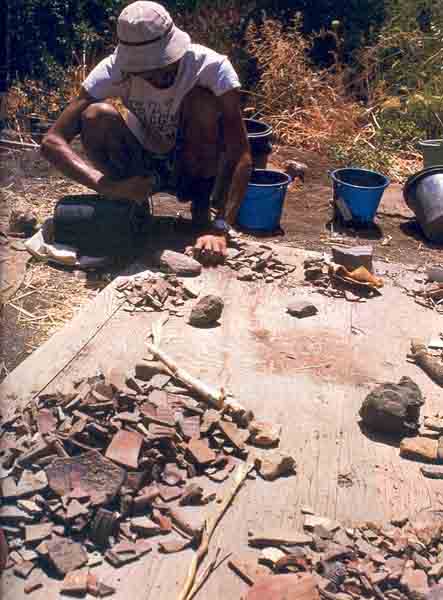
Pottery talks. That’s a little secret archaeologists know but few outsiders are privy to. And pottery can talk—a lot.
If you were to excavate George Washington’s dining room at Mount Vernon and recover fragments of the many plates and cups and bowls and serving dishes used there, you would conclude that our first president cared greatly about food and entertainment. If you went on to excavate the pantry and kitchen and recovered the numerous storage, preparation and cooking vessels that were used there, you would further conclude that this was a household essentially organized around food: its cultivation, storage, processing (by grinding or salting) and seemingly nonstop preparation and service, usually to many people at once.
Happily for historians, we not only know who lived at Mount Vernon, we have written sources concerning what life was like there. These records include Washington’s own diaries and accounts as well as visitors’ descriptions, such as this one from 1782 by the Marquis de Chastellux, a wealthy French nobleman: “[We enjoyed] an excellent breakfast at nine in the morning, a big dinner at two o’clock, tea and punch in the afternoon, and an elegant little supper. [These] divided the day most happily, for those whose appetites were equal to it.”1
The excavation of a house in Italy dating from the fourth through the second centuries B.C.E., on the other hand, would present you with an entirely different picture. There you would find a limited variety among the relatively few vessels, generally plainly finished—in other words, undecorated common pottery. There would be no vessels for large-scale entertaining or even for preparing and cooking different sorts of meals. But as with Mount Vernon, for Republican period Italy there are also written sources that complement the archaeological record. Romans of that time were thrifty, even penurious, as the contemporary Stoic philosopher Poseidonius describes: “The Romans of early times were moderate and highly virtuous in all things. The utensils which [they] bought were of earthenware, and in them were the simplest foods and drinks in the world.”2
As an archaeologist, and specifically as a ceramics (pottery) specialist, I am heartened by the congruence between these written descriptions and their respective collections of household goods. That is because for most archaeological sites, household pottery is abundant but written records identifying the residents and detailing their lives are lacking. It is the job of an archaeological ceramicist to identify that pottery—by fabric, origin, form and function—and then to “read” this material to see what it reveals about the 048people who left it behind. I will explain how pottery is read by using pottery from three different settlements from three different centuries. As it happens, however, all three settlements are found on the same site.
The site is Tel Anafa, a small mound 27 miles east of the Phoenician port of Tyre, in the Hula Valley of northern Israel. The name is modern Hebrew for “Mound of the Water Heron.” The valley’s high water table used to support fish ponds that attracted all kinds of water birds, including herons. Excavations began in 1968 under the direction of Saul Weinberg of the University of Missouri-Columbia. In 1978 the University of Michigan joined the effort, under the direction of Sharon Herbert. By the last season, in 1986, about 20 percent of the mound’s upper levels had been cleared and thousands of artifacts recovered—including more than 22,000 pounds of pottery. That’s 11 tons!3
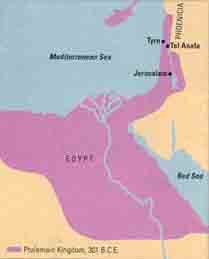
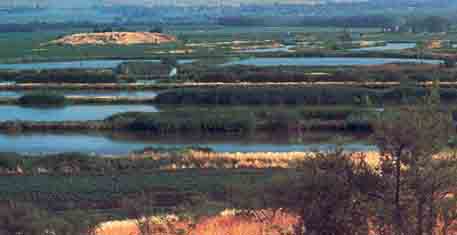
The Third-Century B.C.E. Settlement
The first settlers about whom we have substantial evidence came to Tel Anafa early in the third century B.C.E. (the early Hellenistic period). The discovery of fifteen coins of Ptolemy I (301–280 B.C.E.) allow us to date the settlement. Ptolemy was a general under Alexander the Great. When Alexander died in 323, Ptolemy claimed hegemony over Egypt, Palestine and Phoenicia, the southernmost sections of Alexander’s realms. No one challenged his claim to Egypt, but he spent 30 years fighting for Palestine and Phoenicia. His chief nemesis was Seleucus I, another of Alexander’s generals. Seleucus had claimed the bulk of what had been the Achaemenid Persian Empire, from 049Asia Minor in the west to Bactria in the east and as far south as Palestine. In 301 B.C.E. the two former generals agreed to a division: Seleucus would control northern and central Phoenicia and Ptolemy would control southern Phoenicia and Palestine. Ptolemy’s territories included the Hula Valley, which was largely unsettled at the time.
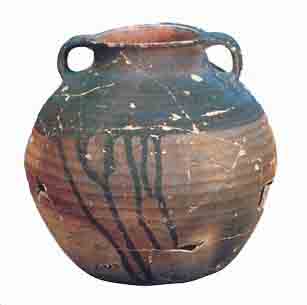
The Ptolemies organized their empire around agriculture and maintained their economy by heavy taxation and constant oversight. For most residents of Palestine, this meant that much of the best agricultural land, including fertile but unsettled land, became royal property, and crops were turned over to or taxed by the crown. Some residents of third-century B.C.E. Palestine earned their keep by supplying the many caravans that crisscrossed the country. The Zenon papyri (the records of a Ptolemaic official named Zenon, who traveled through Palestine in 259/58 B.C.E.) detail the journey and cargo of a camel caravan traveling from Gaza to Sidon to Galilee with dates, mats, pickled grains and meat.4
This was the political and economic environment in Palestine shortly after 300 B.C.E., when the first settlers came to the small outcrop of Tel Anafa. They built two- and three-roomed houses from the small untrimmed boulders available on the site, and they laid out courtyards in between. They put pebbles down for flooring in the rooms, and they tamped dirt for the courtyard surfaces.5 A collection of loom weights, found lined up in a single room, provides evidence of their industry. The faunal remains indicate that they hunted wild pigs and deer and herded cattle.6 For more details about their lives, however, we must read their pottery.
How many and what kinds of vessels did they have? For individual eating and drinking, they had about 100 small bowls and saucers, equivalent in size and shape to modern teacups and saucers. For kitchen chores they had about 30 to 40 large grinding and mixing bowls, called mortaria (singular, mortarium). These bowls, which had exceptionally coarse interiors, were used as graters. One mortarium had been used so much that the bottom had been worn right through. That Anafa’s early Hellenistic settlers had so many mortaria indicates that they were very occupied with basic food preparation.
For cooking, the people of third-century B.C.E. Tel Anafa had about 100 cooking pots, all of one shape: round in body, with a very narrow mouth. This form was designed to keep water from evaporating during cooking. It was used primarily for porridges, soups and legume dishes. Such dishes are well attested in the Near East from the earliest times. Of 34 Akkadian recipes recorded on three tablets from around 1700 B.C.E., 25 describe dishes that must be simmered for a long time in a covered pot.7 In classical times, lentil soup was very popular. Athenaeus, writing in the second century C.E., noted that Alexandria in Egypt was “full of lentil dishes, and everyone there is brought up on lentil food.”8 The remains from Tel Anafa suggest that its third-century settlers subsisted on lentil soup, porridge and similar dishes.
Most of the settlers’ little bowls and saucers, grinding bowls and cooking pots were made of one distinctive ware, which Saul Weinberg dubbed spatter-painted ware after the sloppy looking paint applied to the pottery. Chemical and petrographic analyses, as well the distribution pattern, indicate that spatter-painted ware vessels were made in the Hula Valley.9 There is no evidence for pottery production at Tel Anafa itself, but the residents may have bought these vessels from a single local supplier. The fact that they acquired so many of their household goods locally suggests that they did not participate in the wider economic world.
The settlers did have a few vessels that were not local: about 20 small perfume bottles made of a ware from the southern Phoenician coast. Such bottles 050would have been easily transported by caravans. These are the most luxurious items that have survived from third-century B.C.E. Tel Anafa, and their small number, more than anything else, reveals just how restricted the residents’ resources were.
The saucers, grinding bowls, cooking pots and perfume bottles constitute practically all the ceramic remains of the early Hellenistic settlement. Before considering what this pottery indicates about the settlers, it is important to note what they did not have: any kitchen equipment other than the cooking pots and grinding bowls, imported wine or oil (which would have come in large transport jars), vessels for mixing and serving wine, or serving vessels useful for large gatherings or entertainments. The pottery of Tel Anafa’s first settlers shows that they lived the most basic of lifestyles, very much like their contemporaries, the ascetic Romans.
Who lived at Tel Anafa in the early third century B.C.E.? Perhaps settlers from the Phoenician coast, since the Upper Galilee and the Hula Valley had belonged to the territory of Tyre as recently as the preceding century. But the cosmopolitan coast seems an unlikely origin for people with such poor and unsophisticated household goods. And in the third century B.C.E., the repertoire of cooking vessels at coastal sites was already more varied than that at Tel Anafa. A more likely explanation is that the site was an offshoot of a nearby uphill settlement, such as Kedesh, which was on a caravan route. A few families could have moved (or been moved by a Ptolemaic government official) to farm in the fertile, well-watered valley. Their harvests would then have been taxed by or simply taken for the crown.
The Second-Century B.C.E. Settlement
Sometime around 250 B.C.E., the early Hellenistic farmers abandoned Tel Anafa, and the mound lay uninhabited for more than 100 years. Shortly after 125 B.C.E., towards the end of the Hellenistic period, a new group of 051people settled at the site. They built a large house directly over the tumbled boulders and slumped mudbrick of the previous settlement. This new structure was about 180 feet square and comprised many rooms arranged around a central colonnaded courtyard. The building was luxurious: Its walls were covered with stucco painted to resemble marble, and at least some of the floors were covered with decorative mosaics. The style of the villa’s decor, variously called “Architectural,” “Masonry” and, in Italy, “Pompeian First Style,” was common to wealthy households throughout the eastern Mediterranean at this time.
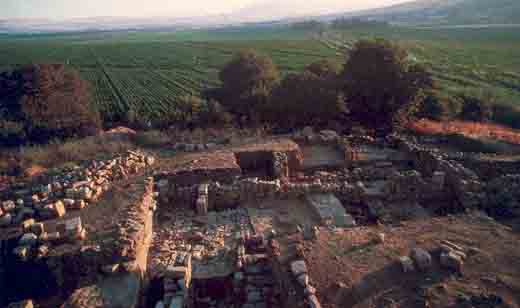
On the east side of the courtyard was a three-room bath complex, with mosaic floors in two of the rooms. Underneath the floor of the central room was a rudimentary hypocaust system constructed of mudbrick pillars through which hot air circulated, heated by a furnace located in the southern room; the northern room was probably a dressing area.10

The villa, with its fancy decor and indulgent personal appointments, presents quite a vivid contrast to the small third-century B.C.E. houses that preceded it. No doubt its residents had a very different lifestyle as well. Just how different becomes clear when we take a close look at their household goods. To begin with, these included fragments of more than 300 perfume bottles, quite a jump from the 20 or so from the previous settlement. Since both settlements lasted for about 50 years, there can be no doubt that the late Hellenistic settlers had more time and money to spend on themselves.
They also had a taste for wine—imported wine no less—as shown by fragments of about 130 wine jars from the islands of Rhodes, Kos, Knido and Chios, as well as eight wine jars from Italy. These people were not snobs; in addition to imported wine, they drank regional imports. There were 37 wine jars from southern Phoenicia—an impressive number, since they would have been acquired full and would have been heavy and difficult to maneuver. These wine jars show how well connected the late Hellenistic inhabitants were with coastal suppliers, whether directly or through regional markets.11
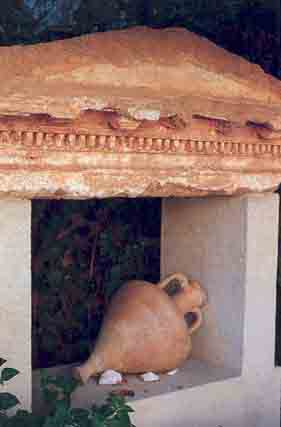
Such a supply of wine indicates an entertainment-oriented household, a characterization confirmed by the presence of 350 serving and pouring vessels, an astonishing quantity that suggests such activities as a Greek symposium or a Phoenician marzeah (a combination guild meeting and festive meal).a Almost all of the serving vessels are of the same ceramic material as the Phoenician wine jars, another indication of these settlers’ close ties to that region and its suppliers. One 052especially interesting aspect of this array is the variety of forms for what was essentially the same function—mixing and serving wine. In antiquity, as today, people liked variety and choice if they could get it.
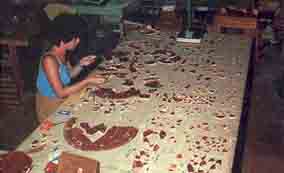
The poor third-century B.C.E. settlers ate and drank their small servings out of plain, locally manufactured saucers and bowls. Their wealthy second-century B.C.E. successors, on the other hand, had a large supply of glass and pottery drinking cups manufactured in southern Phoenicia. The pottery is a beautiful shiny red-slipped ware, known as Eastern Sigillata A. (The term “red-slipped ware” refers to vessels that are covered in an iron-bearing slip before firing and that emerge from the kiln with a smooth, shiny, red surface.) It was used not only for cups, but for plates, bowls and even large platters, which would have set a lovely table indeed.
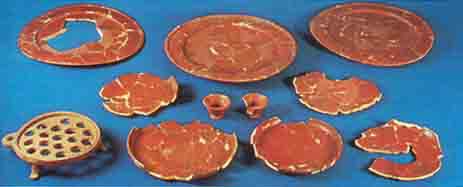
The late Hellenistic villa also yielded a large array of pottery, including about 40 large mixing bowls, 200 small and large jugs, 15 funnels, 30 large storage jars and about 250 grinding bowls. The residents clearly cultivated, processed and stored much of their own food. This conclusion is bolstered by metal implements found at the site and by faunal remains associated with the settlement. Among the metal finds were several sickle blades, and the quantity and ratio of sheep, goat and cattle bones indicate that the settlers were engaged in intensive agriculture. They seem to have been largely self-sufficient.
The quality and number of table vessels show that their owners liked to live it up—George Washington’s hungry marquis would have been well treated here! But can we learn even more from the evidence? Can we tell what Tel Anafa’s second-century B.C.E. residents might have served for dinner?
The late Hellenistic settlers had many more cooking pots than their early Hellenistic predecessors, about 1,200 or so. But they also owned about 650 casseroles, vessels with wide mouths and shallow rounded bodies. Casseroles are rare throughout the Levant, and no similar form exists in the ceramic traditions in the area around Tel Anafa, so it is not surprising that these particular vessels are all of local fabrics, including spatter-painted ware. The site’s new settlers must have commissioned Hula Valley potters to make these vessels. Why?
To answer that, we need to consider what sorts of dishes these casseroles could have accommodated. They are particularly suitable for braising and stewing chunks of meat, fish or large vegetables such as cabbage, procedures not possible with a narrow-mouthed cooking pot. Such dishes are most frequently mentioned by Greek poets and playwrights: Pherecrates talks of boiled animal parts and stewed haddock, Antiphanes of boiled cabbage, and Alexis of meat and fish stewed in a casserole. Typical is this formulation from Sotades: “I [put] two very large pieces of grey-fish in a big casserole; in it I have added sparingly some herbs, caraway-seed, salt, water, and oil.”12
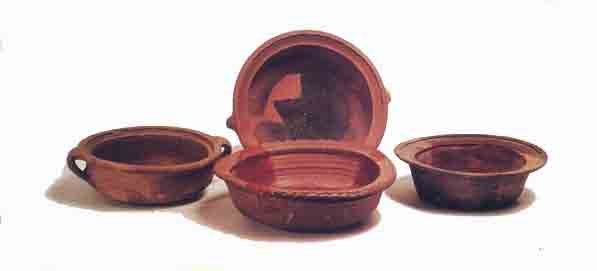
The earliest reference to a dish made in a casserole is from Aristophanes’ Wasps, written in 422 B.C.E. Philokleon, mocking his son’s efforts to steer him away from paid jury duty and towards a more gentlemanly lifestyle, retorts: “I wouldn’t even take pigeon’s milk in exchange for the way of life that you’re now to deprive me of. I don’t take pleasure in skate or eel either; I’d enjoy much more eating a nice little lawsuit, stewed in a casserole.”13
As it happens, it is not only in Greek texts that casseroles appear frequently, but also at Greek sites. In fact, the earliest-known casseroles are late-fifth-century B.C.E. Athenian vessels, contemporary with that citation from Aristophanes, which may suggest both the time and place of the form’s invention. Throughout the late classical and Hellenistic periods (the last four centuries B.C.E.), the casserole was a common form of cooking vessel in Athens and throughout the Greek Aegean.
Looking even more closely at the pottery, and considering which pottery was locally made and which was acquired from outside suppliers, we gain even more clues to the settlers’ identity and lifestyle. Many of the wine jars and almost all of the perfume bottles, juglets and serving vessels were made in southern Phoenicia. But almost all of the 053cooking and preparation vessels were made of the local spatter-painted ware from the Hula Valley. So despite easy access to coastal and other imported wares, Tel Anafa’s late Hellenistic settlers commissioned and acquired many of their household wares from local potters. This shows that the settlers depended upon, and integrated themselves into, the local economy. They put down economic roots in the area.
Who resettled Tel Anafa in the late second century B.C.E.? Anafa’s first settlement occurred when Palestine was part of the Egyptian-based empire of the Ptolemies. Towards the end of the third century B.C.E., while Tel Anafa and most of the Hula Valley lay unoccupied, the Seleucid monarch Antiochus III renewed his dynasty’s claim on Phoenicia and Palestine, and for several years he fought the Ptolemaic king for dominance over the area. In 198 B.C.E. Antiochus III defeated Ptolemy V at the Panion, a shrine to the Greek god Pan (modern Banias, only a few miles north of Tel Anafa), and won control of Phoenicia and Palestine. But Palestine did not remain Seleucid for long, or at least not all of it. In the 160s B.C.E. the Jewish population of Jerusalem and Judea revolted against the religious edicts of the Seleucid monarch Antiochus IV. The Jews fought and defeated the Seleucid forces and declared their independence, thus establishing the Hasmonean kingdom. As the century wore on, various Seleucid kings continued to lose other regions of their empire, with the unhappy consequence that their revenues declined considerably. As a recourse, they allowed cities to buy their independence. In 125 B.C.E., right before the second group of settlers arrived at Tel Anafa, both Tyre and Sidon took advantage of this opportunity, purchasing their independence from Seleucid political control and its attendant burdens of taxation.
The political picture in late-second-century B.C.E. Palestine was a complicated one: The Hasmonean state controlled lands as far north as the upper Galilee; newly independent Tyre controlled hinterlands that extended at least to Tel Kedesh, about 15 miles southwest of Tel Anafa; a local tribe, the Itureans, had begun moving south from the Beqa’ Valley into the northern Golan; and the Seleucids continued to hold parts of southern Syria. The Hula Valley sat smack in the middle of these various sociopolitical entities.
No written evidence identifies the residents of the Hula Valley in the late second century B.C.E. The pottery found at Tel Anafa, however, speaks to us even while the written historical record is silent. The socioeconomic world of Tel Anafa’s residents included the Hula Valley itself, as the quantity of spatter-painted cooking, kitchen and utility wares attest; southern Phoenicia, where all of their serving and table wares were made and where they also acquired perfume and wine or oil; and the eastern Mediterranean islands, which provided the bulk of their supply of wine. The number and variety of vessels for large-scale entertainment shows them to have been both wealthy and cosmopolitan. The large number of vessels for storing, processing and preparing food shows them to have been agriculturally self-sufficient as well. Finally, their taste in food reflects aspects of Greek culture.
Among the various possibilities for the settlers’ identity, one group can be quickly ruled out: Jews from Hasmonean-controlled lands. Among the villa’s pottery there is not a single vessel that conforms in form or fabric to wares found in southern Palestine—not a perfume bottle, not a jar for wine or oil, not a cooking pot, not 054even a plate. The Jewish state apparently presented a closed border, economically and probably socially as well. Another possibility, Iturean pastoralists from the adjacent Golan, also seems quite unlikely, given the settled and sophisticated character of the pottery assemblage.
Taking everything into account, I suggest that the site’s second group of residents were Hellenized Phoenicians, probably from Tyre. After Alexander’s conquest of the city in 332 B.C.E., Tyre received an influx of Greek settlers. By the second century B.C.E., they had established Greek athletic contests and Greek cults. While the Phoenician coastal plain was crowded, the nearby Hula Valley was fertile and largely unpopulated. As their ambitious building program and their integration into the local economy makes clear, the new settlers came to stay. As the amount of imported vessels reflects, they were in no sense exiles: They fostered and maintained market connections that allowed them to live and entertain in a lavish and sophisticated manner.
The First-Century C.E. Settlement
The late Hellenistic settlers left Tel Anafa by 75 B.C.E. Unfortunately, we don’t know why. The stone and mudbrick walls of the courtyard villa collapsed on themselves, forming a thick solid layer above the foundations and pavings. About 75 years later, in the early first century C.E., a third group of people resettled the site. By this time, the political situation was quite different. By the early 60s B.C.E., both the Hasmonean and Seleucid kingdoms, nominally still in control of much of the region, were beset by feuds, unreliable alliances and outright revolts. In 63 B.C.E. the Roman general Pompey took over the former heartland of the Seleucid realms, established the new Roman province of Syria and transformed Judea into a client state. Although nominally independent, Judea was required to pay an annual tribute to Rome.
Judea was ruled, at first, by a man named Antipater, who passed his position on to his son, Herod. By the time of Herod’s death in 4 B.C.E., his kingdom had expanded, largely through land grants given him by the emperor Augustus, to include lands well beyond the Jordan River. At his death, Herod’s kingdom was divided among his three sons. Herod Archelaus, the eldest, received Judea and Samaria; Herod Antipas, the middle son, received the Galilee; and Herod Philip, the youngest, received a large tract encompassing much of what is now northern Jordan, the Golan Heights and areas east. The little Hula Valley formed a part of Herod Philip’s western border, and in 2 B.C.E., at the old sanctuary of Pan, just north of Tel Anafa, Herod Philip established a new city and capital for his kingdom, which he called Caesarea Philippi.
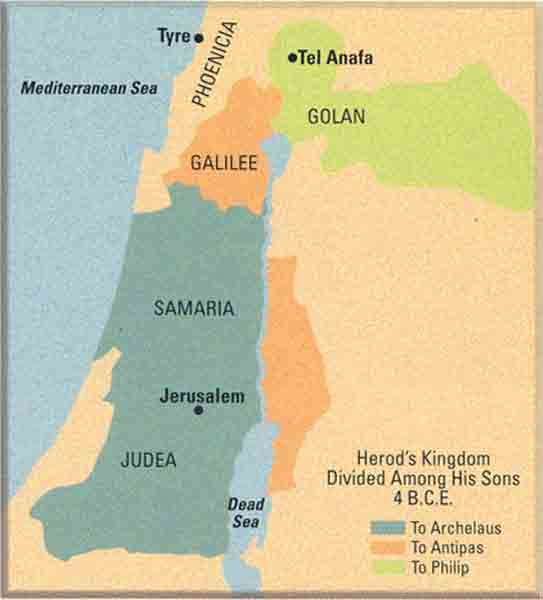
It was shortly after this time that new settlers moved to Tel Anafa. Like the earliest settlers, they built three or four structures of one or two rooms each. These were found immediately above the slumped mudbrick debris of the ruined second-century B.C.E. villa. The walls of these new buildings were made of irregularly trimmed stone, chinked in with smaller stones to create a solid, if not overly aesthetic, construction.14 This plan reflects a settlement less indulgent and luxurious than the villa but sturdier and more organized than the boulder-walled 055houses of Tel Anafa’s earliest settlers in the third century B.C.E.
The faunal remains include a great many cattle bones, of which just under half belong to very young animals. So large a number suggests that they were imported for consumption. There were also sheep and goat bones, with sheep disproportionately represented. This indicates that large areas of fallow land must have been available for pasturage, which in turn suggests that the settlers were not primarily farmers.15 Now, what does their pottery tell us?
These first-century C.E. settlers had their share of fine red-slipped cups, plates and bowls, just as the second-century B.C.E. residents had. In marked contrast, however, they had very few personal items, such as perfume bottles. Only 55 such vessels were found, a number that may roughly correspond to the number of residents during this period. What they did possess in some quantity was a variety of cooking vessels: about 300 cooking pots, the sort good for soup, along with about 100 deep casseroles for stewing and braising.
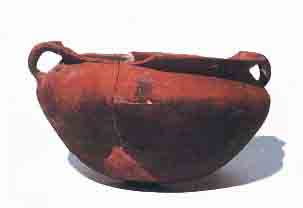
Both the early and the late Hellenistic residents of Tel Anafa acquired their cooking vessels from potters in the Hula Valley. All of the cooking pots and casseroles belonging to the first-century C.E. settlers, on the other hand, were of a recognizable ware made in the village of Kfar Hananiah, in the Lower Galilee.16 Rabbinic texts describe the pottery of Kfar Hananiah as especially durable and heat retentive.17 It was therefore likely more expensive than the local spatter-painted ware vessels of the Hula Valley. Interestingly, almost none of this period’s pottery was made in the Hula Valley itself.
Instead, Tel Anafa’s first-century C.E. inhabitants imported much of their pottery, even though goods from outside the borders of the Herodian kingdoms were now more expensive because they were subject to customs duties. From southern Phoenicia came all the residents’ regional imports of fine red-slipped table wares, such as plates and bowls. From the Galilee, where Tel Anafa’s first-century C.E. residents acquired their cooking vessels, came many large storage jars (for grain, oil or wine).
Although trade with the Galilee may have been easier because it was ruled by Herod Philip’s brother, Galilean goods were not necessarily bargains, since they arrived via an overland supply route at least as long as that from the Phoenician coast. That Tel Anafa’s early-first-century C.E. settlers chose so many more Galilean goods than Phoenician ones shows that unlike their second-century B.C.E. predecessors, they had no cultural or ethnic connection to the coast.18 Clearly, larger political, social and economic forces were at work.
Almost none of the first-century settlers’ pottery came from the Hula Valley. What did come from there was a third kind of cooking vessel, something new for the region: a kind of baking dish or pan. These differ from the other types of cooking vessels found at the site in that they are low, fairly straight walled and flat bottomed. And, like the casserole, these pans are highly unusual in Near Eastern kitchens—rare, in fact, throughout the eastern Mediterranean. Where they are common is in Italy and at western Mediterranean sites colonized by Rome. For those sites during the first century B.C.E., pans often make up more than half of the cooking ware assemblages. Tel Anafa’s early-first-century C.E. residents had about 125 pans, more than ten percent of all their kitchen pottery. That’s quite a lot for a completely new shape.
Cooking pots are good for soups, and casseroles are good for stews. What are pans designed for? They are particularly suited for dishes whose ingredients must set or thicken: The shallow, straight sides and flat bottom impart definition to baked goods and allow for easier serving. Many recipes requiring pans appear in the cooking manual of Apicius, a first-century C.E. Roman cook and cookbook writer. Most common are recipes for patinae, to which an entire chapter is devoted.19 Here, straight from Apicius, is a recipe for a Roman patinae: First, lay a selection of chopped fish, 062vegetables or fruit in a pan; pour an egg mixture over this; and bake it. This sounds remarkably like a quiche, which is not surprising, since an ancient pan looks remarkably like a modern quiche dish.
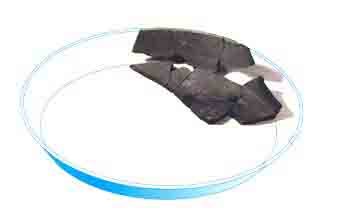
The last piece of ceramic information about Tel Anafa’s first-century C.E. inhabitants comes from other sorts of kitchen pottery, such as mixing bowls, jugs, funnels and especially grinding bowls. Surprisingly, they had almost none, only about ten grinding bowls and a few jugs and juglets. This is probably because these settlers did not grow and process their own food, unlike the villa residents and the third-century B.C.E. settlers before them.
So who were the people who came to Tel Anafa in the early first century C.E.? As with both previous settlements, no written sources survive, and we must read the ceramic remains for clues. Their few cosmetic vessels, and the absence of vessels for large-scale entertaining, indicate that they were businesslike, eminently practical and hardly self-indulgent. But the quantity of imported tablewares, as well as the Galilean cooking vessels and jars, indicates that although they lived simply, they were not at the economic margins, as were the third-century B.C.E. settlers. The absence of processing and preparation vessels, such as grinding bowls, suggests that they were not farmers. Finally, and most interestingly, the quantity of pans they commissioned reveals a taste for Roman cuisine.
We can identify one group whose characteristics meld with everything mentioned above: soldiers, that is, Roman or Italic mercenaries employed by Herod Philip. Soldiers are not farmers, and they do not live extravagantly. They do tend, however, to be quite concerned with food and drink, which are their readiest palliative against boredom. They are paid well enough to buy the supplies they need. And if they manned Tel Anafa on behalf of Herod Philip as a guardpost for the capital at Caesarea Philippi, they could be assured of continued supplies from the Lower Galilee, which was at the time controlled by his brother Herod Antipas.20
If this picture is correct, it would also help explain Tel Anafa’s abandonment around the middle of the first century C.E.
Herod Philip died in 34 C.E., and his realms reverted to the governor of Roman Syria. Just three years later, however, Caligula became emperor, and he handed back Herod Philip’s domains to his friend Herod Agrippa, a grandson of Herod the Great and a favorite of the Roman court. After Agrippa died in 44, these territories were turned over to the Roman prefect residing at Caesarea Maritima, on the Mediterranean coast. When the region came under the control of distant and uninterested Roman authorities, the site’s raison d’etre disappeared, and it was, for the third and last time, abandoned.
Tel Anafa was a small site, in an out-of-the-way place. It was not the sort of site, and its settlers were not the sort of people, that make it into the pages of history books. But they left behind so informative a category of archaeological remains—their household pottery—that with a little ingenuity, we can recover much of their history, after all.
Pottery talks. That’s a little secret archaeologists know but few outsiders are privy to. And pottery can talk—a lot.
You have already read your free article for this month. Please join the BAS Library or become an All Access member of BAS to gain full access to this article and so much more.
Already a library member? Log in here.
Institution user? Log in with your IP address or Username
Footnotes
Endnotes
Marquis de Chastellux, Travels in North America in the Years 1780, 1781 and 1782, vol. 2, ed. Howard C. Rice, Jr. (Chapel Hill: Univ. of North Carolina Press, 1963), p. 383.
Sharon Herbert et al., Tel Anafa, vol. 1, Final Report on Ten Years of Excavation at a Hellenistic and Roman Settlement in Northern Israel, Journal of Roman Archaeology Supplementary Series 10.1 (1994); W. Farrand, “The Geological Setting,” Tel Anafa, vol. 1, pp. 265–278; Richard Redding, “Vertebrate Fauna,” Tel Anafa, vol. 1, pp. 279–322; Ya’akov Meshorer, “Coins,” Tel Anafa, vol. 1, pp. 241–260; Donald T. Ariel and Gerald Finkielsztejn, “Stamped Amphora Handles,” Tel Anafa, vol. 1, pp. 183–240; Andrea Berlin and Kathleen Slane, Tel Anafa, vol. 2.1, The Hellenistic and Roman Pottery:The Plain Wares and the Fine Wares, Journal of Roman Archaeology Supplementary Series 10.2 (1997).
P. col. 205, in William Linn Westerman and Elizabeth Sayre Hasenoehrl, Zenon Papyri: Business Papers of the Third Century B.C. Dealing with Palestine and Egypt, vol. 1 (New York: Columbia Univ. Press, 1934), pp. 4–5.
Berlin, “From Monarchy to Markets: The Phoenicians in Hellenistic Palestine,” Bulletin of the American Schools of Oriental Research 306 (1997), pp. 75–88.
Berlin and Slane, Tel Anafa, vol. 2.1, pp. 14–15; David Adan-Bayewitz, Common Pottery in Roman Galilee: A Study of Local Trade (Ramat Gan: Bar-Ilan Univ. Press, 1993), pp. 224–227.
This last conclusion has been given additional support from a few of the metal finds: three very corroded Roman pilum, or javelin, points. The pilae are not all of the same type, and their forms are a bit out of date for this period. This suggests that they were acquired piecemeal or secondhand, which would fit quite well with reservists in the employ of a client-king. I thank Gloria Meker for this information.
